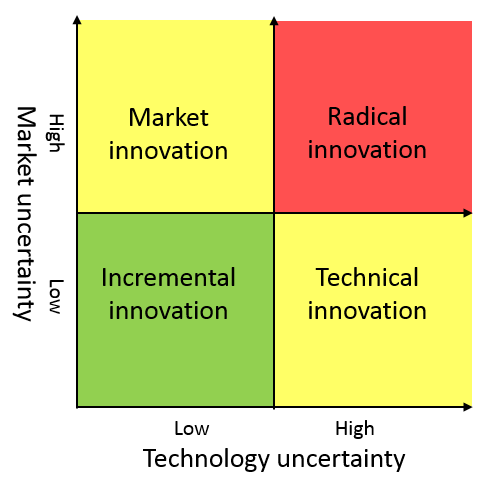
Uncertainty of Innovations

Both of these options have their places but you must be aware on what you are doing. Successfully identifying the risks that uncertainties cause to innovations may play important role in innovation management.
Technological uncertainty
Innovations and technology have strong relationship and new technology development continuously creates new innovations. Technology innovations widely include both the technical tools and the knowledge needed to use the tools. While technology drives opportunities for new innovations implementing new technology creates uncertainty on the success of the innovation. Innovation’s technical feasibility, usefulness, functionality or quality problems way delay or fail the innovation. Technological uncertainty in innovation arises due to lack of knowledge of the details of new technology or due to lack of knowledge required to use new technology. New technologies not only require new technical skills but also new business models in where those technical capabilities become valuable (Välikangas & Gibbert 2005). Ortt and Smits (2006) have stated that “technology does not offer itself as ready-made packages, but more as opportunities” and the relevance of past practice for new technology becomes increasingly uncertain (Scranton 2007).
Market uncertainty
Innovation without a market is has no value. The idea of innovation is that it is invented and implemented in order to meet the need (real or perceived) of the market. A market for innovation consists of the needs of customers, the actions of competitors, and the prices of substitutive commodities. Uncertainties exist predicting future market conditions when “the disruptive effects of emerging technologies, empowered customers, new market entrants, shorter product life cycles, geopolitical instability, and market globalization” (Muller & Välikangas 2005). Important sources of uncertainty is customers. The uncertainty regarding the demand for the innovation, the unknown behavior of customers and unclear customer needs are main sources of uncertainty caused by customers. It is particularly challenging to estimate what consumers might want in the future (Harris & Woolley 2009). Market uncertainty also manifests itself as lack of knowledge about the behavior of competitors. Innovation requires organization to do things differently from its competitors. It is difficult to do things differently because organization cannot know what its competitors’ intentions might be. The predicting price development of competing products, services and raw materials needed may cause uncertainty in the innovation process. Uncertainty arises because price development is dependent on many factors associated with the demand and supply of raw materials, predictions for which are impossible.
In summary, the market uncertainty in innovation exists, on the one hand, due to unforeseeable changes in relations between firms and customers and, on the other hand, due to unforeseeable changes in relations between competitors from which new markets emerge.
Manage different Innovation types
By evaluating the market and technology uncertainties, you can categorise innovations to different innovations types. Incremental, Market, Technical or Radical innovations. By doing so you can plan different approaches to manage innovation projects. It’s good to have a lot of incremental innovations that are managed by agile methods. If you plan a radical innovation project, you need robust risk management.
Read next

